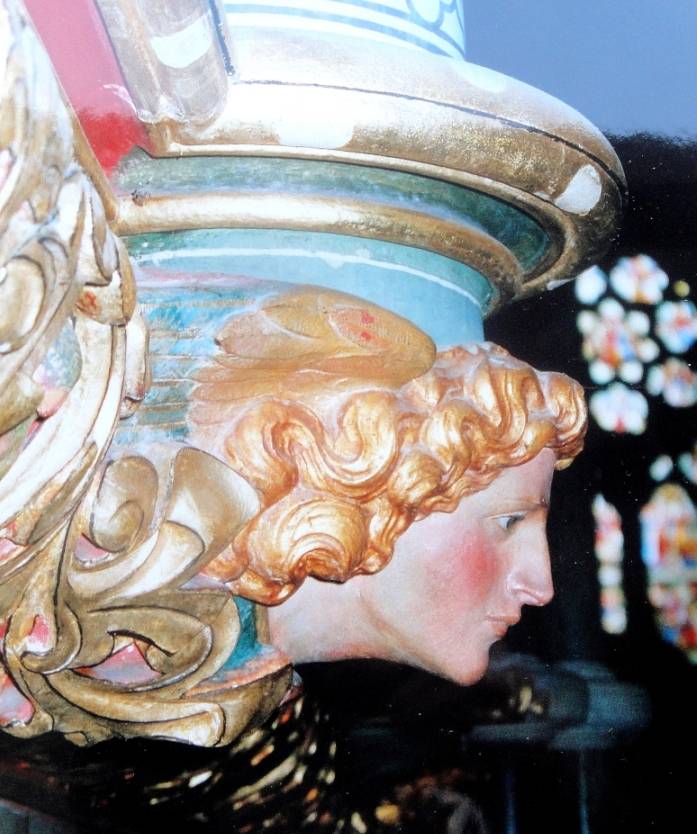

Left: Bird-carvings round an arch. Right: Musicians in a canopied niche on the organ case. Thomas Nicholls was the "favourite craftsman" of the architect William Burges (Leach 7), and his usual stone-carver in both secular and ecclesiastical work. Here he was employed in the rich ornamentation of St Mary, Studley Royal, the estate church of the Marquess and Marchioness of Ripon in Yorkshire, which was started in 1871 and consecrated in 1878. The main features of the nave are the white, exquisitely carved organ-case on the north aisle, with its spiral stair, and the tomb of the Marquess and Marchioness on the south side — the latter added later, so not” by Nicholls. As for the bird motif shown here, Burges often used birds, especially parrots, in his designs. For example, birds are carved into the bench-ends of the choir-stalls here (see below) and even sit in the scrolling of the ironwork of the church's west door.


Sculpted and brilliantly painted faces — a feature of the decoration of the chancel. With its colourful marble wall-shafts, stained glass and frescoes, the chancel of St Mary's makes a dramatic contrast to the serenity of the nave. As Simon Jenkins says, the church really "bursts into colour" (901) here. Polychromatic sculpture was typical of the Burges/Nicholls partnership: even Nicholls's animals on the Animal Wall in Cardiff had originally been painted, and of course the interiors of both Cardiff Castle and Castell Coch are a riot of colour too. Here, the scenes depicted in the sculpture-work and painted decoration relate to the Book of Revelations (Jenkins 901), or more generally to the theme of "paradise lost and paradise regained" (Williams 7).


Left: Angel trumpeter” by the east window. Standing out from the two tiers of angels and saints painted on the chancel walls, a thoughtful-looking, highly-coloured angel holds a trumpet: "And I saw the seven angels which stood before God; and to them were given seven trumpets" (Revelations 8, 2). Right: Lion of Judah seen from the chancel (upper part of picture) and bird carved in the choir stall's bench-end (lower right-hand corner). Nicholls seems to have been equally accomplished in carving both stone and wood.
Related Material
- St Mary, Studley Royal, Yorkshire.
- High relief figures on the font, St Mary, Studley Royal
- Christ the Consoler, Skelton-on-Ure
- The Yorkshire Dales in Victorian Times, Part II: Religion
All photographs except for the last on the right by Robert Freidus. You may use the images without prior permission for any scholarly or educational purpose as long as you (1) credit the photographer and (2) link your document to this URL in a web document or cite the Victorian Web in a print document. Last photograph on the right © Colin Hinson, of the Genuki: Yorkshire Genealogy website, cropped from a larger one that he kindly contributed it to the Victorian Web. This should not be reused without his permission. Formatting by the author. [Click on the images to enlarge them.]
Bibliography
Jenkins, Simon. England's Thousand Best Churches. London: Penguin, 2000.
Leach, Peter. St Mary's Church, Studley Royal. (Dept. of the Environment Official Handbook.) London: HMSO, 1981.
Leach, Peter, and Nikolaus Pevsner. Yorkshire West Riding, Leeds, Bradford and the North (The Buildings of England series). New Haven & London: Yale University Press, 2009.
Williams, Matthew. William Burges. Norwich: Jarrold (Pitkin Guides), 2007.
Last modified 2 December 2011